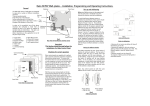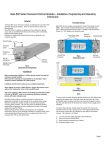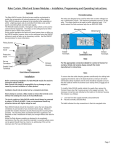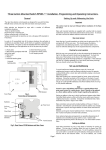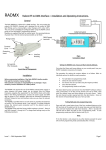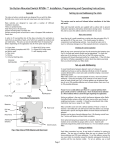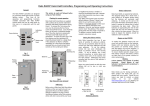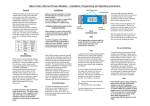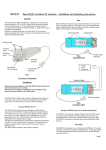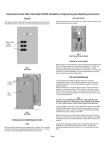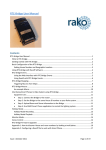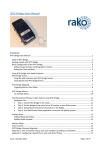Download Rako RCP07 Wall-plates (externally powered
Transcript
Rako RCP07 Wall-plates (externally powered) – Installation, Programming and Operating Instructions. General Setting Up and Addressing the Units The Rako RCP series of wall-plates are designed to cope with a number of different installation situations. These are predominantly: Flush fixing into a UK back-box. Surface mounting with a UK back-box Surface mounting with no back-box or onto a European DIN standard or French box. Important In order to fit successfully into all the above situations the wall-plate is made from an assembly of parts, all of which are supplied as standard and are listed below. The parts can also be identified from the drawing Fig1. (Note: Depending on the application not all of the parts may be used) 1 x Front plate. 1 x PCB retainer (complete with PCB and button pad). 1 x Rear cover. 1 x Patress. 1 x Universal backing plate. 2 x 6mm M3.5 fixing screws. 2 x 25mm M3.5 fixing screws. 2 x 12mm M3.5 fixing screws. 2 x self-tapping screws. 1 x Terminal block Universal backing plate This section be read and followed before installation of the Rako control panel. Rear cover removal. Insert the tip of a small screwdriver or similar into the prise point (Fig. 2) and gently lift off the rear cover. This should expose the addressing switches. Care should be taken not to touch or otherwise damage any of the exposed electronic components. Addressing Setting an address is the way in which interference between other Rako systems, either with other rooms within your house or neighbouring houses is avoided. It should be remembered that with a booster unit a Rako transmitter may have a range of over 100m. Your Rako control panel comes set with a default address of House 1 Room 4 and whilst the unit will function with this address it is strongly advised to select your own house address and logical room addresses. Fig. 3 illustrates how the house and room addressing avoids interference. Special Addresses Patress PCB Retainer Front Plate Fig 1. Front View of Components It should be noted that certain room addresses can have special functions. Room 0 acts as an overall master control for all the rooms within a house. This maybe useful if it is desirable to have a master control panel which controls all the rooms together, say for master On/Off panels at main entrances but should be avoided if master control is not intended. It is also possible to have room grouping, see Fig.4 (only accessible using Rasoft software), whereby rooms are clustered into groups of 4 with the first address in each group acting as a master, therefore room 5 is a master for rooms 6,7, & 8, room 9 is a master for rooms 10, 11 & 12 and so on. This may be a useful feature if, for example, bedside lighting needs individual control but still needs to be turned off at the main bedroom panel at the door. Room 0 still acts as an overall house master as well as for its own group of rooms 1,2 & 3. As room grouping may become desirable at a later stage it is recommended to avoid setting room addresses to those which would become slave rooms within a group. This is done by leaving room address switches 1 & 2 in the off position, see Fig. 5. Power Leads Prise Point Addressing Switches Aerial Cutouts Fig 2. Rear View of PCB Retainer and Rear Cover Page 1 House XXX House XXY Room 0 Room 0 Room 0 Has overall control of all rooms in the house House XXX Room 0 Room 0. Overall control Room 0 Has overall control of all rooms in the house Room AAA Room AAA No Interference between houses with different addresses Room AAB Individual Room Control Individual Room Control No Interference between rooms with different addresses Room AAA Individual Room Control Room AAB Individual Room Control No Interference between rooms with different addresses Room AAB Group master. Controls all rooms within group Group master. Controls all rooms within group Room AAA+1 AAB+1 Room AAB+1 Room AAA+3 AAB+1 Room AAA+2 AAB+1 No interference between rooms within a group Room AAB+3 Room AAB+2 Fig 4. Rako addressing with grouping enabled. Fig 3. Rako house and room addressing Receiver modules not only have house and room addresses but also a channel address, which can be set from 1-15 for each room. This channel address is what allows different circuits to be set at different levels for each scene. Setting all of these addresses is achieved by a single command from a wall-plate in programming mode. The procedure for setting the receiver address is as follows. See the relevant section for details on each step. House address = 128+16=144 • • • • • • ROOM 128 64 32 16 8 4 2 1 ON ON 128 64 32 16 8 4 2 1 BINARY VALUE Each Rako transmitter has two, 8 way banks of switches for setting its address. The two sets of switches allow the user to choose from 256 house addresses and 256 room addresses (64 groups of 4 with grouping enabled). To set the address, unclip the rear cover whereupon the banks of switches will be now become visible. To set an address, use a small terminal screwdriver or similar device and carefully move some of the switches into the ‘ON’ position. Addressing uses binary encoding and the value of the switches is shown below. HOUSE Setting receiver addresses. BINARY VALUE Setting an Address ROOM BECOMES A SLAVE ROOM WITH EITHER OF THESE SWITCHES SET ON AND GROUPING ENABLED Room address = 32+4=36. Fig 5. Addressing Switches Once the addresses have been set it is strongly recommended to keep a note of the settings and to keep these in safe place. Whilst it is easy to set the addresses, those of the receiver units are normally only set once. To do so requires access to the units and once set these may be installed in inaccessible positions. If, therefore the wall-plate address get changed for any reason and the original settings cannot be remembered then access to the receiver units will be needed for reconfiguration. Note: Put wall-plate into programming mode. Find an available channel. Put receiver into set–up mode. Press the ident button. Exit programming mode on wall-plate. Exit set-up mode on receiver (done automatically when using the magnet method). Putting Wall-plate into programming mode. Press and hold a scene button (one of the four numbered buttons on the left hand side of the plate) and at the same time press and hold both the raise and lower buttons (the right hand buttons). After 3 seconds the LED will start to flash, the plate is now in programming mode. To exit programming mode press the Exit button (see Fig. 7). Note: If the Exit button is not pressed or any other buttons pressed the panel will exit from programming mode automatically after 3 minutes. LED indicator Scene buttons Master raise and lower buttons Once the address for a control panel has been set the transmitter, or at least one transmitter within a room, needs to send its address to all the receiver modules that it needs to control. This can either be done before or once the control panel has been installed. Fig 6. Wall-plate buttons in normal mode Page 2 Approximate position for Rako programming magnet. Channel scroll up Magnet Level up Channel scroll down Ident Level down Store Fig 8. Set-up Magnet Positioning Exit Note: Fig 7. Wall-plate buttons in programming mode Setting a receiver’s address. The first step is to find an available channel address for the receiver. For convenience, this is usually the next available channel after all the already allocated addresses. To identify which channels already have allocated addresses first put the wall-plate into programming mode. Then, using the Channel scroll up and Channel scroll down keys scroll through the 15 available channel addresses. When a channel address is reached which already has a receiver allocated, that receiver will flash its load in a slow double pulse to identify itself. Channel 0 will flash all the channels in a fast quadruple flash indicating the start point (note: it is not possible to program a receiver to channel 0. Scroll through until you find an available channel i.e. a channel where no load flashes, or to another specific channel that you wish to set the receiver to and then stop. This is the channel identity that will be sent to the receiver when the Ident key is pressed. Next put the receiver into set-up mode (see putting receiver into set-up mode) and then press the Ident button. The receiver will flash its load to acknowledge receipt of the command and then automatically drop out of set-up mode (unless using the header connector method, see notes). The receiver has now registered the house, room and the specific channel address that it should respond to. If no more set-up commands are to be sent by the wall-plate then press the Exit key to return the panel to normal operating mode. Note: If no commands are received from the wall-plate within 3 minutes the receiver will automatically come out of set-up mode. The receiver will also come out of programming mode if the power to the unit is interrupted. Programming a lighting scene. To program a scene firstly choose which scene is to be programmed or reprogrammed. Press and hold that scene button and at the same time press and hold both the master raise and lower buttons. After 3 seconds the panel will go into programming mode and the LED will start to flash. Next, using what are now the Channel scroll up and down buttons, scroll through to a channel whose level needs to be altered. As the channels are scrolled through they will each, in turn, flash their loads to indicate which is the current channel. At any time pressing the ident button will flash the currently selected channel without scrolling on. When the appropriate channel has been reached use the channel raise lower buttons to alter the lighting level for that load. Scroll through the remaining channels changing the lighting levels until the desired scene has been set. Pressing the store button will save all current levels to that scene and all the receivers should now flash their load again to confirm that the levels have been stored. Press the Exit key to return the Wallplate to normal mode. Note: When re-programming a lighting scene it is quite possible to enter programming mode, select and alter only one or two channels and re-set their levels without adjusting any of the remaining channels. Thus fine tuning a scene becomes a simple and easy task. For ease of use it is generally advisable to set the channel addresses in a sequence from channel 1 onwards. It is possible to set two receivers to the same channel address. This has been deliberately made possible, as it may be desirable to have two receivers that always respond together fading to exactly the same lighting levels. For example there may be two identical up-lighters, both fed from independent receivers, which need to always respond as one. Putting receiver into set-up mode. Firstly ensure that the receiver has been connected correctly, that the unit is powered up and that a suitable lighting load is connected. Using the small magnet provided with each receiver, press the magnet against the receiver casing just over halfway down (see Fig.8). The approximate position for this is indicated by the ‘magnet point’ legend on the top label. When the magnet is in the correct position an internal LED will illuminate. The LED will stay on with a steady illumination all the time that the magnet is in the correct position. Hold the magnet in this position for 3 seconds until the LED starts to flash. The receiver is now in set up mode. Page 3 Installation Before assembly ensure that the rear cover is firmly fixed and that the aerial is positioned in a way as to not foul other components. Warning Rako wall-plates are designed to operate at safety extra low voltages (12V). When fixing the wall-plates to existing back-boxes there may be mains wiring present, if this is the case then the wiring should be made safe, properly insulated and any metal back-boxes earthed. Earthing of the back box is essential if a decorative metal front plate is being used. Should there be any doubt in how to do this contact a qualified electrician. Rako Controls Ltd accepts no responsibility for any damage or injury caused by incorrect installation of a Rako product. Whilst Rako control panels’ radio data transmission offers reliable, trouble-free operation, Rako control panels should not be solely relied upon for lighting in safety critical installations. Surface fixing to UK back box. Power Connection Externally powered Rako control panels require a D.C. power supply such as the RAPSU power supply unit. Otherwise a power supply delivering 912V with a 20mA or better capacity should be used, the Rako panels have an internal voltage regulator so un-regulated supplies may be used. The positive (+ve) lead on the panel is labelled and coloured black and the negative lead is white. Connect these to the power supply using the connector block provided. Note that connecting the supply with the wrong polarity will not damage the panel although the panel will not function. Warning: Only power supplies conforming with SELV (Safety Extra Low Voltage) requirements should be used. General Rako thanks you for having purchased a Rako product and hopes that you are pleased with your system. Should for any reason you need to contact us please contact us via our website www.rakocontrols.com or by phoning our customer help line on 0870-043-3905. Orientate the patress so that the bossed inserts are aligned vertically and locate the PCB retainer in the patress. Then using the 25mm fixing screws fix the front plate to the retainer and patress and back-box. Flush fixing to a UK back-box Fit the PCB retainer in the back-box so that the clear flange is flush to the wall. Then using the 12mm fixing screws (or 25mm if needed) secure the front plate to the PCB retainer and back-box. Note. If a metal front plate is being used, as per the Rako RPP accessories, then the aerial must be positioned outside of the back-box. This is because the front plate and back-box will form a ‘Faraday cage’, which will give very poor radio transmitting conditions. To position the aerial correctly a hole must be cut in the back-box and a small diameter hole drilled into the wall. Straighten the aerial and push the aerial into the hole. The best radio transmission will be achieved when all of the aerial fully extended and outside of the back-box. If, because of physical constraints, it is not possible to drill the hole in a position close to where the aerial emerges from the PCB retainer, then the rear cover can be removed and the aerial re-positioned in a more convenient aerial cut-out (see fig 2). Surface fixing to European back-boxes. For fixing to European DIN or French standard back-boxes the Rako universal backing plate has been designed so that two of the fixing slots match European DIN standard back-box fixings and two match standard French back-box fixings. To mount the assembly, orientate and mount the universal backing plate as applicable (screws not provided) and then follow the instructions for ‘Surface fixing with no back-box’. Not e that cut-out guides have been provided for access for the power supply leads. Cut out one of these holes as appropriate. Page 4





